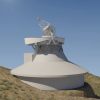
University of Exeter to support construction of largest ever European Solar Telescope
The University of Exeter is part of a consortium of universities that will develop designs for the biggest solar telescope ever constructed in Europe.
Nine European countries including the UK have joined forces to commit to the construction of the European Solar Telescope (EST), which it is hoped will provide unparalleled insight into the phenomena of space weather.
Launched in 2008, the European Solar Telescope project aims to improve understanding of the mechanisms underlying solar flares and coronal mass ejections. These events determine so-called ‘space weather’, which can lead to geomagnetic storms on earth – seen as the northern lights – and have a strong influence on our technological society.
The University of Exeter is part of the United Kingdom Universities Consortium (UKUC) led by the University of Sheffield, which today (25 July) signed the deed of the EST’s Canary Foundation in Santa Cruz, Tenerife.
The agreement sees six UK universities – Aberystwyth, Belfast, Durham, Exeter, Glasgow and Sheffield – along with a further six European countries, commit to the construction of the telescope at the world-renowned El Roque de los Muchachos Observatory, at La Palma in Spain.
Professor Andrew Hillier of the University of Exeter’s Department of Mathematics and Statistics said: “Solar research at The University of Exeter focuses on theoretical aspects of the coupling between fluids and magnetic fields. Being part of the investment towards EST gives us a very exciting pathway towards testing our ideas.
“Our researchers investigate large-scale phenomena like prominence eruptions to small-scale energy transfer and dissipation process with the aim of understanding how mass and energy are transferred in the solar atmosphere.
“The design of EST is such that we will be able to probe these very small spatial scales, providing key observations to help explain transport and dissipation processes, whilst capturing the larger processes in the extreme detail needed to understand them.”
One of the EST’s primary objectives is to improve understanding of the Sun by observing its magnetic fields in unprecedented detail. Once operational, it will be able to uncover signals currently hidden in the noise and reveal the existence of unknown, tiny magnetic structures.
The optical configuration and instrumentation of EST have been meticulously designed to study the magnetic and dynamic coupling of the solar atmosphere, and capture the interactions between the different atmospheric layers of the Sun.
Additionally, a comprehensive set of instruments will be installed to enable simultaneous observations across multiple wavelengths. This unique capability will give the EST a higher efficiency compared to existing or future telescopes, whether ground-based or space-borne.
Professor Robertus von Fay-Siebenburgen, from the University of Sheffield’s School of Mathematics and Statistics, will be a principal investigator for the UKUC project. He said: “The EST will be the biggest ground-based solar telescope constructed in Europe and will keep its European partners at the forefront of solar physics research, so it's fantastic that so many UK partners have been able to come together to join the EST Canary Foundation today.
“This kind of unrivalled research infrastructure will provide European astronomers and plasma-astrophysicists with an extraordinary tool for observing the Sun and its space weather, one that will pave the way for scientific advancements in some of the world’s biggest and most important challenges, such as the development of green fusion energy.
“By being able to study the physical processes happening in the solar chromosphere in such detail for the first time, we will gain new insight into how the heating mechanisms occur that underpin the plasma heating processes. Learning from how nature does it will help us explore how to replicate the process for the benefit of humankind.”
The preliminary design phase of the telescope, which was funded by the European Commission’s Horizon 2020 programme, has recently been completed. After a construction period of six years, the EST’s first light – or becoming operational – is planned for 2028-29.
The establishment of the EST Foundation marks a crucial milestone in advancing the project towards the construction phase. One of the primary objectives of the Foundation is to create a European Research Infrastructure Consortium (ERIC), which will bring together the national ministries of the partner countries. The EST ERIC will be the legal entity responsible for overseeing all aspects of the construction and operation of this large research infrastructure.
For more information about the project, please visit: www.est-east.eu














